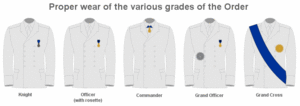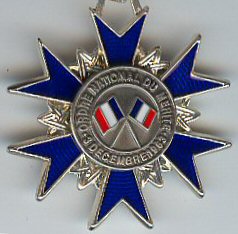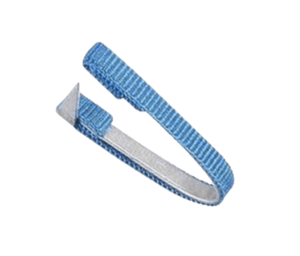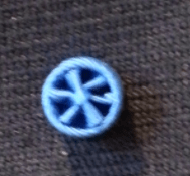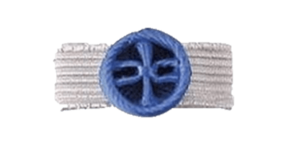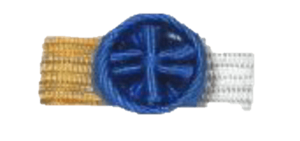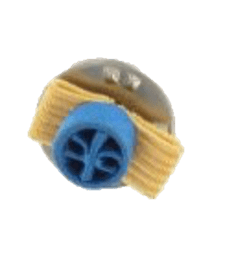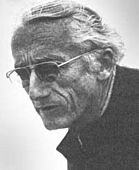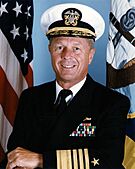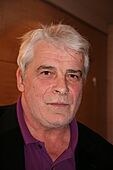Ordre national du Mérite facts for kids
Quick facts for kids Ordre national du Mérite |
|
|---|---|
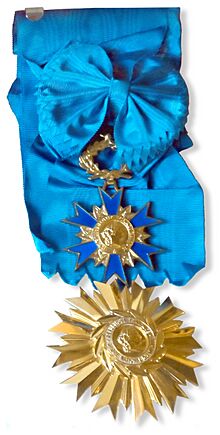
Sash, badge and star of a Grand Cross
|
|
| Awarded by the President of France | |
| Type | Order of merit |
| Established | 3 December 1963 |
| Ribbon | Blue |
| Awarded for | Distinguished civil or military achievements |
| Status | Active |
| Grand Master | President Emmanuel Macron |
| Grades | Grand Cross Grand Officer Commander Officer Knight |
| Statistics | |
| First induction | 1963 |
| Precedence | |
| Next (higher) | Military Medal |
| Next (lower) | National Recognition Medal for Victims of Terrorism |
| Related | Order of Agricultural Merit Order of Maritime Merit |
Grand-croix Officier Chevalier Ribbon bars of the order |
|
The Ordre national du Mérite (which means "National Order of Merit" in English) is a special award in France. The President of the French Republic gives this award to people who have done great things for their country. It was started on December 3, 1963, by President Charles de Gaulle.
This award was created for two main reasons. First, it replaced many smaller awards that different government departments used to give out. Second, it offered an award for achievements that were important but perhaps not quite at the level of the very famous Legion of Honour. Over the years, hundreds of thousands of people have received this honor.
Contents
History of the National Order of Merit
The National Order of Merit has recognized many people since it began. About 185,000 people are currently members. In its first 50 years, over 306,000 people were given this award or promoted within it. A cool fact is that half of the people who receive this award are required to be women.
Awards Replaced by the Order
Before the National Order of Merit was created, France had many different awards. These awards were given by various government ministries or for specific colonial services. The new Order of Merit brought all these different awards under one main system.
Some of the older awards it replaced included:
- The Order of the Star of Anjouan (from 1874)
- The Order of Light (from 1887)
- The Order of the Black Star (from 1889)
It also replaced many special awards for different jobs, like:
- The Order of Societal Merit (from 1936)
- The Order of Public Health (from 1938)
- The Order of Commercial and Industrial Merit (from 1939)
- The Order of Sports Merit (from 1956)
- The Order of Military Merit (from 1957)
How the Order is Organized
The National Order of Merit has clear rules about who can join and how it works.
Who Can Receive the Award?
Both French citizens and people from other countries can receive this award. It is given to men and women who have shown outstanding achievements in military or civilian life. These achievements are important, but they are usually not as high-level as those needed for the Legion of Honour.
The President of the French Republic is the main leader of the order. This leader is called the Grand Master. The President chooses all the members, usually based on advice from the French government. The Order of Merit shares an office and a leader (called a Chancellor) with the Legion of Honour. Every Prime Minister of France automatically becomes a Grand Cross of the order after serving for six months.
Different Levels of the Order
The Order has five different levels, just like the Legion of Honour. These levels show how long someone has been a member and how much they have achieved.
- Knight (Chevalier): This is the first level. To become a Knight, a person must be at least 35 years old. They also need to have at least 10 years of public service and have shown "distinguished merits." For military officers, this level is usually reached after 15 years of good service.
- Officer (Officier): To become an Officer, a Knight must have been at that rank for at least 5 years. For military officers, this is achieved after seven years as a Knight.
- Commander (Commandeur): To become a Commander, an Officer must have been at that rank for at least 5 years. For military officers, this is achieved after five years as an Officer.
There are also two higher levels, called dignities:
- Grand Officer (Grand Officier): To reach this level, a Commander must have been at that rank for at least 3 years.
- Grand Cross (Grand-Croix): This is the highest level. To become a Grand Cross, a Grand Officer must have been at that rank for at least 3 years.
What the Insignia Looks Like
The medal and star of the Order were designed by a French sculptor named Max Leognany.
- The medal is a blue, six-pointed star with laurel leaves between the points. It looks like a Maltese cross. The front has the head of Marianne, who represents the French Republic. The back shows French flags and the name of the order with its founding date.
- The star (or plaque) is worn by Grand Officers and Grand Cross members. It's a sunburst shape with twelve points, often with blue enamel rays. The center also features the head of Marianne and the name of the Order.
- The ribbon for the medal is a solid blue color. For the Officer level and higher, a small flower-like decoration called a rosette is added to the ribbon.
Here is how the different levels wear their insignia:
- Knight – wears the medal on the left side of their chest.
- Officer – wears the medal with a rosette on the left side of their chest.
- Commander – wears the medal around their neck.
- Grand Officer – wears the medal with a rosette on the left side of their chest, plus the star on the right side of their stomach.
- Grand Cross – wears a wide sash from their right shoulder to their left hip, and the star on the left side of their stomach.
| Ordre national du Mérite Ribbons | ||||
|---|---|---|---|---|
Knight |
Officer |
Commander |
Grand Officer |
Grand Cross |
Buttonhole Ribbons
People often wear smaller versions of their award ribbons on their lapels or buttonholes. These small ribbons also show their rank in the Order.
| Knight | Officer | Commander | Grand Officer | Grand Cross |
Famous People Who Received the Order
Many well-known people, both from France and other countries, have been honored with the National Order of Merit.
-
Commandant Jacques Cousteau, a Grand-Croix of the Ordre national du Mérite.
Here are some of the notable people who have received this award:
French Citizens
- Charles Aznavour, a famous actor and singer
- Jean-Paul Belmondo, a well-known actor
- Arnaud Beltrame, a brave gendarme officer
- Jacques Cousteau, a famous ocean explorer
- Alain Delon, a popular actor
- Gérard Depardieu, an actor and filmmaker
- President Charles de Gaulle, who founded the order
- Isabelle Huppert, a talented actress
- Marcel Marceau, a famous mime artist
- President François Mitterrand, a former President of France
- Teddy Riner, a World and Olympic champion in judo
- Sylvie Vartan, a popular singer
- Cédric Villani, a brilliant mathematician
- Victor Wembanyama, an Olympic silver medalist basketball player
Foreign Nationals
- Queen Aishwarya of Nepal
- Tina Arena, a musician and actress from Australia
- Julia Child, a famous chef from the United States
- King Juan Carlos I of Spain
- Queen Sofia of Spain
- Queen Letizia of Spain
- Frederik X, King of Denmark
- Queen Mary of Denmark
- General Wesley Clark, a military officer from the US
- Kamal Haasan, an actor from India
- Queen Máxima of the Netherlands
- Empress Emerita Michiko of Japan
- General Mark A. Milley, a top US Army officer
- Generalleutnant Franz Pöschl, a German military general
- Queen Camilla of the United Kingdom
- Queen Sonja of Norway
- Queen Silvia of Sweden
- King Willem-Alexander of the Netherlands
- Princess Galyani Vadhana, a Princess of Thailand
- Victoria, Crown Princess of Sweden
- Catherine, Princess of Wales
See also
 In Spanish: Orden Nacional del Mérito (Francia) para niños
In Spanish: Orden Nacional del Mérito (Francia) para niños
- List of Foreign recipients of the Ordre national du Mérite
- Order (decoration)
- Ribbons of the French military and civil awards
- State decoration


